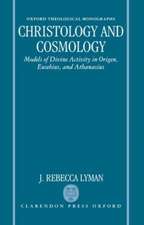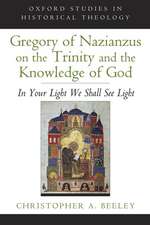Arianism: Roman Heresy and Barbarian Creed
Autor Guido M. Berndt Editat de Roland Steinacheren Limba Engleză Paperback – 30 iun 2020
| Toate formatele și edițiile | Preț | Express |
|---|---|---|
| Paperback (1) | 327.44 lei 6-8 săpt. | |
| Taylor & Francis – 30 iun 2020 | 327.44 lei 6-8 săpt. | |
| Hardback (1) | 1064.52 lei 6-8 săpt. | |
| Taylor & Francis – oct 2014 | 1064.52 lei 6-8 săpt. |
Preț: 327.44 lei
Nou
Puncte Express: 491
Preț estimativ în valută:
62.65€ • 65.65$ • 51.80£
62.65€ • 65.65$ • 51.80£
Carte tipărită la comandă
Livrare economică 11-25 aprilie
Preluare comenzi: 021 569.72.76
Specificații
ISBN-13: 9780367600266
ISBN-10: 0367600269
Pagini: 400
Dimensiuni: 156 x 234 x 23 mm
Greutate: 0.54 kg
Ediția:1
Editura: Taylor & Francis
Colecția Routledge
Locul publicării:Oxford, United Kingdom
ISBN-10: 0367600269
Pagini: 400
Dimensiuni: 156 x 234 x 23 mm
Greutate: 0.54 kg
Ediția:1
Editura: Taylor & Francis
Colecția Routledge
Locul publicării:Oxford, United Kingdom
Cuprins
Contents: Preface; Introduction: framing the historical and theological problems, Hanns Christof Brennecke; Ulfila und der sogenannte gotische Arianismus, Knut Schäferdiek (Â…); Ulfila and the so-called ’Gothic’ Arianism - English summary, Knut Schäferdiek (Â…); Was Ulfila really a homoian?, Sara Parvis; Sabas: ’orthodox’ or ’Arian’?, Paul Parvis; The Homoians, Uta Heil; Deconstruction of the so-called Germanic Arianism, Hanns Christof Brennecke; Vulfila pontifex ipseque primas Gothorum minorum, sed non apostolus eorum. Vulfila, bishop and secular leader of his people but not their apostle, Herwig Wolfram; Barbarian ’Arian’ clergy, church organization, and church practices, Ralph W. Mathisen; Germanic language and Germanic Homoianism, Brendan Wolfe; The non-archaeology of Arianism - what comparing cases in Carthage, Haïdra and Ravenna can tell us about ’Arian’ churches, Ralf Bockmann; The ecclesia legis Gothorum and the role of ’Arianism’ in Ostrogothic Italy, Guido M. Berndt and Roland Steinacher; Arrianorum abolevit heresem: the Lombards and the ghost of Arianism, Piero Majocchi; Arianism in Africa, Robin Whelan; Arianism and ethnic identity in 6th century Visigothic Spain, Manuel Koch; The Homoians in Gaul, Uta Heil; Britain: approaching controversy on the western fringes of the Roman Empire, Meritxell Pérez MartÃnez; Conclusion: the elusive nature of an orthodox heresy, Yitzhak Hen; Bibliography; Index.
Notă biografică
Guido M. Berndt is a researcher at the Department of Ancient History, Friedrich-Alexander-Universität, Erlangen-Nuremberg, Germany; Roland Steinacher is a historian specialising in Roman History at the Institut für Mittelalterforschung of the Austrian Academy of Sciences and teaches at the University of Vienna, Austria.
Recenzii
'... an important contribution to the literature on Arianism ... the essays in this volume give a rounded and nuanced picture of the state of current understanding of the religion and the social organization of the various Germanic peoples in late antiquity and the early Middle Ages.' Bryn Mawr Classical Review
Descriere
This is the first volume to attempt a comprehensive introduction to and overview of the evolution of the 'Arian' churches in the Roman world of Late Antiquity and their political importance in the late Roman kingdoms of the 5th-6th centuries, ruled by barbarian warrior elites. Bringing together researchers from the disciplines of theology, history



















